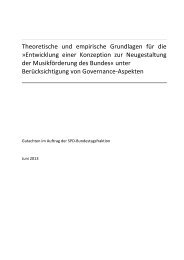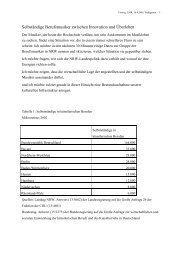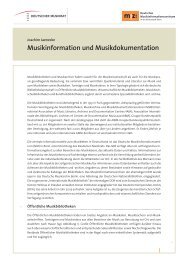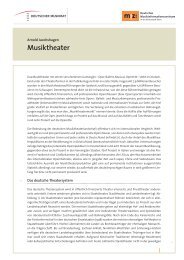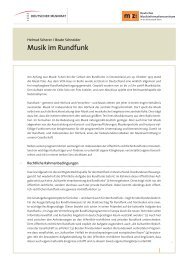You also want an ePaper? Increase the reach of your titles
YUMPU automatically turns print PDFs into web optimized ePapers that Google loves.
Taylor Swift<br />
In Asia, around a quarter of the music<br />
business is now composed of digital<br />
revenues, set against a backdrop of<br />
sharply falling physical sales (<strong>IFPI</strong>).<br />
<strong>Digital</strong> sales in China, Indonesia,<br />
South Korea and Thailand now<br />
account for more than half of all<br />
music sales. South Korea has seen<br />
the benefits of a stronger copyright<br />
environment and there has been<br />
strong growth in MP3 subscription<br />
services (see page 26). Japan, the<br />
biggest market in the region, was<br />
hit by mobile piracy and economic<br />
downturn, seeing CD sales fall by<br />
more than 20 per cent in the first<br />
half of 2009, while digital sales<br />
were flat.<br />
Strong downloading demand helped<br />
Australia become one of the few<br />
developed music markets to achieve<br />
the “holy grail” of overall growth in<br />
2009, as the rise in digital music sales<br />
offset a small decline in revenues from<br />
physical formats. <strong>Digital</strong> album sales<br />
nearly doubled in 2009, representing<br />
almost 8 per cent of overall album<br />
sales, and digital albums are proving<br />
especially popular in the early days<br />
after a title’s release (ARIA). Some local<br />
artist releases, for example those by<br />
Australian artists Eskimo Joe, Hilltop<br />
Hoods and Paul Dempsey, saw digital<br />
album sales of between 15 and 20 per<br />
cent of total first week sales.<br />
Europe continues to lag behind in<br />
digital adoption, with only around<br />
15 per cent of sales coming from<br />
digital channels. In 2009 however,<br />
Europe was the fastest growing region<br />
in terms of digital sales.<br />
A study by Jupiter Research in March<br />
2009 highlighted some reasons for<br />
Europe’s digital lag:<br />
n The impact of music piracy – there<br />
are 29.8 million frequent users of<br />
file-sharing services in the top five<br />
EU markets alone and other forms of<br />
piracy are growing. Trends indicate a<br />
north-south divide, with Italy and Spain<br />
showing considerably higher piracy<br />
levels. Paid digital music services have a<br />
fundamental problem in competing with<br />
widespread illegal downloading.<br />
n Europe’s higher taxation levels compared<br />
to the US, different royalty structures and<br />
a fragmented rights landscape makes<br />
pan-European licensing a resourceintensive<br />
and complicated process.<br />
n High-street retail consolidation started<br />
earlier in the US. This drove active<br />
music fans online earlier, both to<br />
online CD retailers such as Amazon<br />
as well as digital stores.<br />
n The $0.99 à-la-carte model has been<br />
better suited to the US compared to the<br />
fragmented European market given the<br />
comparatively low margins, which favour<br />
large players and economies of scale.<br />
Latin America closely follows Europe<br />
in terms of digital share, with nearly<br />
15 per cent of revenues coming from<br />
digital channels. Brazil is the biggest<br />
digital market in the region and saw<br />
the successful development of services<br />
including Nokia Comes With <strong>Music</strong> and<br />
Terra Sonora in 2009. Mexico saw the<br />
introduction of the iTunes store in August<br />
2009 – the first in the region.<br />
11<br />
Beyoncé<br />
Globally, single tracks crossed the<br />
1.5 billion mark for the first time,<br />
up an estimated 10 per cent on 2008.<br />
<strong>Digital</strong> albums grew an estimated<br />
20 per cent, double the rate of single<br />
tracks. Today, around 20 per cent<br />
of albums sold in the US are digital<br />
and around 15 per cent in the UK<br />
(RIAA, BPI).<br />
The best selling single track of 2009<br />
was Lady Gaga, selling a total of<br />
9.8 million units. By comparison,<br />
the best-selling digital single track<br />
in 2008, Lil Wayne’s Lollipop, sold<br />
9.1 million units and in 2007 Avril<br />
Lavigne’s Girlfriend sold 7.3 million<br />
units (<strong>IFPI</strong>).<br />
Global mobile music revenues fell in<br />
2009, hit by piracy, lack of operator<br />
support for music services in some<br />
markets and saturation of the<br />
mastertones sector. On the other<br />
hand, single track mobile downloads<br />
were stable and ringback tones<br />
continued to grow thanks to strong<br />
sales in the US, Japan and India.<br />
<strong>Music</strong> subscriptions continued, and<br />
are expected to grow, account for<br />
more than 5 per cent of digital sales<br />
in 2009 (<strong>IFPI</strong>). Services such as<br />
TDC PLAY, Nokia Comes With <strong>Music</strong>,<br />
Spotify Premium and Vodafone drove<br />
this growth. Despite still accounting<br />
for a modest share of overall digital<br />
revenues, advertising-supported<br />
revenues are also expected to<br />
show strong growth in 2009. n




